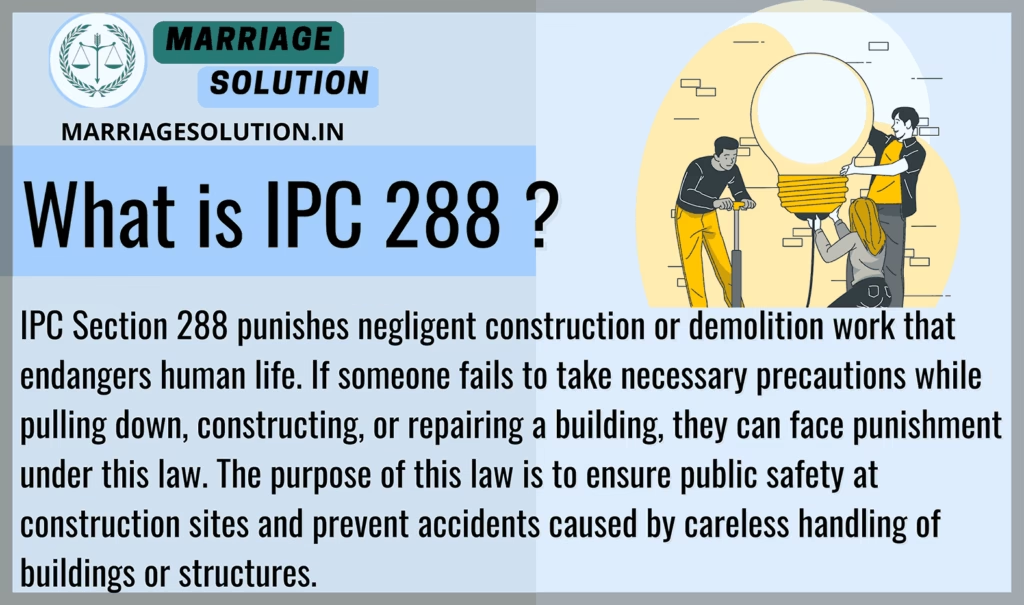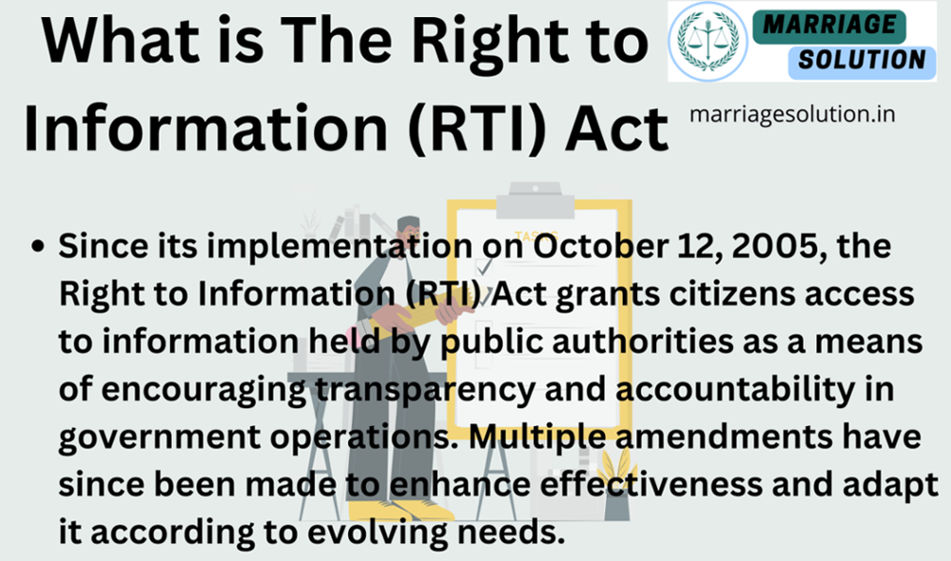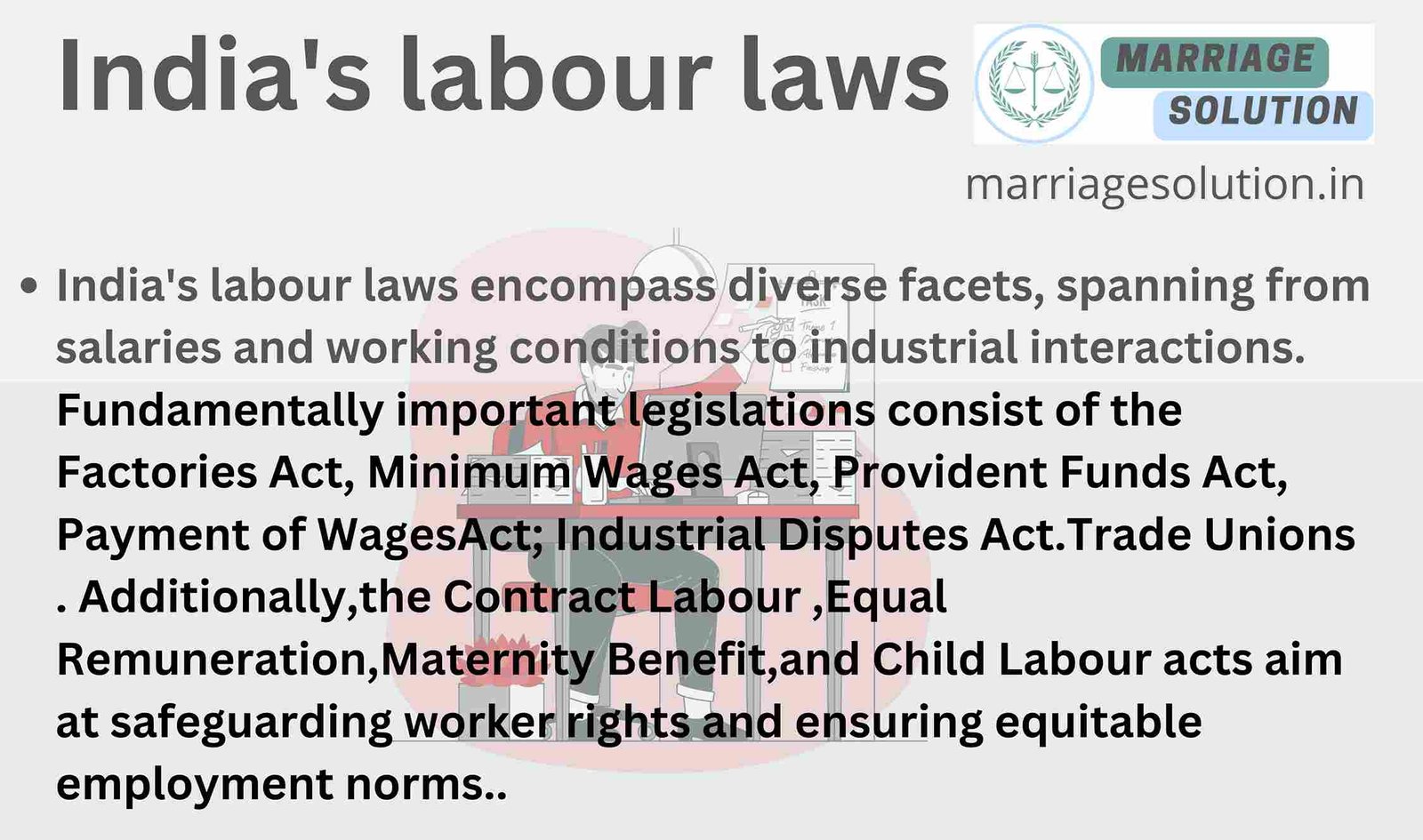Introduction of IPC 288
IPC 288 is a legal provision in the Indian Penal Code (IPC), 1860, that deals with negligent conduct in construction, demolition, or repair of buildings. This law is designed to prevent accidents and injuries caused by unsafe construction practices. It ensures that individuals responsible for demolishing, repairing, or constructing buildings take proper safety measures to avoid harm to human life or damage to nearby structures.
- Introduction of IPC 288
- What is IPC Section 288?
- Section 288 IPC in Simple Points
- Section 288 IPC Overview
- Examples of IPC 288
- Section 288 IPC case laws
- 288 IPC Punishment
- 288 IPC Bailable or non bailable
- Section 288 IPC in short information
- IPC Section 288 FAQs
- If you need support with court proceedings or any other legal matters, don’t hesitate to reach out for assistance.
What is IPC Section 288?
IPC Section 288 punishes negligent construction or demolition work that endangers human life. If someone fails to take necessary precautions while pulling down, constructing, or repairing a building, they can face punishment under this law. The purpose of this law is to ensure public safety at construction sites and prevent accidents caused by careless handling of buildings or structures.

Section 288 IPC in Simple Points
1. Safety Violations in Construction and Demolition
Construction and demolition require proper safety measures to protect workers and the public. If a person fails to put up barriers, warning signs, or protective gear at a site, they can be held liable under IPC 288. Unsafe practices such as ignoring safety protocols, improper use of heavy machinery, or unplanned demolitions can cause serious harm and are punishable by law.
2. Endangering Human Life Due to Negligence
Negligence in construction work can result in severe injuries or even loss of life. If a builder or worker fails to secure falling debris, operate machinery carelessly, or demolish a building without proper safety checks, they endanger human life. IPC 288 ensures that those responsible for such negligence are punished, preventing similar accidents in the future.
3. Legal Consequences for Violators
Anyone found guilty under IPC 288 can be punished with imprisonment of up to 6 months, a fine of up to ₹1,000, or both. The severity of punishment depends on the level of negligence and whether it resulted in injuries or damages. Courts consider the circumstances of the incident before deciding on punishment to ensure fairness in the legal process.
4. Applicability to Contractors, Engineers, and Property Owners
IPC 288 applies to builders, contractors, engineers, site supervisors, and property owners who are responsible for construction and demolition work. If they fail to follow safety regulations, they can be held legally accountable. This law encourages professionals to take proper precautions and ensure that all safety measures are strictly followed.
5. Importance of Following Safety Regulations
Construction and demolition involve high risks, and ignoring safety rules can cause disasters. IPC 288 acts as a preventive measure, ensuring that safety procedures are followed to protect workers, pedestrians, and nearby properties. Using protective barriers, warning signals, and expert supervision can help prevent accidents and ensure compliance with the law.
Section 288 IPC Overview
Whoever, in pulling down or repairing any building, knowingly or negligently omits to take such order with that building as is sufficient to guard against any probable danger to human life from the fall of that building or any part thereof, shall be punished with imprisonment of either description for a term which may extend to six months, or with fine which may extend to one thousand rupees, or with both.
IPC 288: Negligent Conduct in Construction and Demolition
- Importance of Safety in Construction and Demolition
Section 288 of the IPC is essential for ensuring safety during construction, demolition, or repair of buildings. Any person involved in such work must take adequate precautions to prevent accidents. If a structure collapses due to negligence, it can cause serious injuries or even loss of life. This law holds builders, contractors, and workers accountable for maintaining safety standards. Failure to follow safety guidelines can lead to punishment under this section. - Applicability to Builders, Contractors, and Workers
This section applies to anyone engaged in construction or demolition work, including builders, contractors, site supervisors, and workers. If they neglect safety measures, they can be held legally responsible. For example, failing to place warning signs, safety barriers, or protective gear can be considered negligence. The law ensures that everyone involved in construction projects follows safety rules to prevent injuries to workers and the general public. - Legal Responsibility for Accidents and Injuries
If a person fails to take necessary precautions while pulling down or repairing a building, and it causes harm to someone, they can be charged under IPC 288. This includes improper handling of heavy materials, lack of protective fencing, or failure to warn people about potential dangers. Even if no actual harm occurs, the mere act of negligence is enough for legal action, as it puts public safety at risk. - Negligence in Using Scaffolding and Heavy Equipment
Scaffolding is an important part of construction, and it must be properly installed and secured. If it is placed incorrectly, it can collapse and cause injuries. Similarly, heavy equipment like cranes, bulldozers, and lifting machines must be used responsibly. Carelessness, such as not securing loose materials or overloading scaffolding, is considered an offense under IPC 288. Proper training and strict safety checks are necessary to avoid such dangers. - Liability in Case of Building Collapse
If a building or any part of it collapses due to negligence, the person responsible can be prosecuted under IPC 288. This applies whether the collapse happens during construction, demolition, or repair work. For instance, if a wall is removed without proper support, causing the structure to fall, the owner, engineer, or contractor may be legally punished. The law ensures that all safety precautions are taken before starting such work. - Protection for the Public from Unsafe Construction
Construction sites are not only dangerous for workers but also for the general public. If safety measures are not in place, passersby or nearby residents may get injured. Section 288 ensures that proper barricades, warning signs, and secure fencing are used to protect public safety. If someone is harmed due to carelessness, the responsible party can be fined or imprisoned under this section. - Punishment for Violation of IPC 288
Anyone found guilty under IPC 288 can face imprisonment for up to 6 months, a fine of up to ₹1,000, or both. The severity of the punishment depends on the extent of negligence and its consequences. If someone is seriously injured or killed due to reckless construction work, the accused may face more severe legal consequences under related IPC sections. This law aims to promote responsible construction practices. - Role of Government and Construction Authorities
Government agencies and municipal bodies play a crucial role in monitoring construction activities to ensure compliance with safety regulations. They conduct inspections and enforce building codes. If a builder or contractor violates safety norms, authorities can take action under IPC 288. Regular safety training programs and strict licensing requirements help reduce the risk of accidents. - Connection with Other IPC Sections
IPC 288 is closely related to IPC Sections 304A (causing death by negligence), 336 (endangering life), and 287 (negligent conduct with machinery). If negligence under IPC 288 leads to serious injuries or fatalities, additional charges may be applied. Courts consider the extent of negligence, level of risk, and harm caused when determining punishment. This ensures that violators face appropriate legal action. - Preventive Measures and Best Practices
To avoid legal consequences under IPC 288, builders and contractors must follow strict safety guidelines. This includes using quality materials, maintaining proper scaffolding, training workers, and securing the site. Protective gear such as helmets, gloves, and harnesses should be mandatory for workers. By implementing proper safety measures, construction companies can prevent accidents, protect workers and the public, and avoid legal trouble under IPC 288.
Examples of IPC 288
Example 1: Unsafe Demolition of a Building
A builder started demolishing an old building without proper safety measures. During the demolition, a portion of the wall collapsed, injuring a person walking nearby. Since the builder failed to put up warning signs and safety barriers, he was charged under IPC 288 for negligent conduct.
Example 2: Negligence at a Construction Site
A construction company ignored safety protocols while building a high-rise apartment. They did not provide helmets or safety harnesses to the workers, leading to an accident where a worker fell and got seriously injured. The company was held liable under IPC 288, and the court imposed a fine and ordered safety improvements.
Section 288 IPC case laws
1. State vs. XYZ Construction Pvt. Ltd. (2017)
Facts: A construction company failed to install proper scaffolding, leading to the collapse of an under-construction wall, which injured a pedestrian.
Judgment: The court held the company guilty under IPC 288 and imposed a fine of ₹10,000, along with safety compliance conditions.
2. Ram Singh vs. State of Maharashtra (2015)
Facts: A contractor neglected safety measures while demolishing an old building, causing debris to fall on nearby shops, damaging property.
Judgment: The contractor was convicted under IPC 288 and ordered to compensate the victims along with a 6-month imprisonment sentence.
3. Municipal Corporation vs. Ajay Sharma (2020)
Facts: A builder ignored municipal safety notices and continued unsafe demolition work. As a result, part of the structure collapsed, injuring workers.
Judgment: The court fined the builder ₹20,000 under IPC 288 and municipal building laws, ensuring strict safety compliance in future projects.
4. People vs. Vinod Contractors (2018)
Facts: A lack of proper fencing and warning signs at a demolition site caused a motorcyclist to meet with an accident.
Judgment: The contractor was found guilty under IPC 288 and ordered to pay compensation to the victim, in addition to a ₹5,000 fine.
5. State of Karnataka vs. Ramesh Builders (2019)
Facts: Heavy machinery was operated without precautions, leading to an accident where two workers were injured.
Judgment: The court imposed a fine of ₹15,000 and directed strict implementation of safety measures for future projects.
288 IPC Punishment
- Imprisonment – A person guilty under IPC 288 can face up to 6 months in jail if their negligent act poses a serious risk to workers, nearby residents, or passersby.
- Fine – The court may impose a fine up to ₹1,000 to penalize the offender and ensure they take proper safety measures in future.

288 IPC Bailable or non bailable
Yes, IPC 288 is a bailable offense. This means the accused can apply for bail and does not have to remain in jail until trial. However, the court may impose conditions to ensure that the accused follows safety regulations in future projects.
Section 288 IPC in short information
| IPC Section | Offense | Punishment | Bailable/Non-Bailable | Cognizable/Non-Cognizable | Trial |
|---|---|---|---|---|---|
| IPC 288 | Negligence in construction or demolition that endangers human life | Imprisonment up to 6 months, or fine up to ₹1,000, or both | Bailable | Non-Cognizable | Tried by Magistrate |
IPC Section 288 FAQs
What is IPC 288?
IPC 288 punishes negligent conduct during construction, demolition, or repair of buildings that could endanger human life.
Is IPC 288 a bailable offense?
Yes, IPC 288 is a bailable offense, meaning the accused can get bail from the court.
Is IPC 288 a cognizable offense?
No, IPC 288 is a non-cognizable offense, meaning the police cannot arrest the accused without prior court approval.
What is the punishment under IPC 288?
The punishment includes imprisonment up to 6 months, a fine of up to ₹1,000, or both, depending on the severity of negligence.
Who can be held liable under IPC 288?
Builders, contractors, site supervisors, and engineers can be held responsible if they fail to take proper safety precautions.
If you need support with court proceedings or any other legal matters, don’t hesitate to reach out for assistance.
Court or any other marriage-related issues, our https://marriagesolution.in/lawyer-help-1/ website may prove helpful. By completing our enquiry form and submitting it online, we can provide customized guidance to navigate through the process.
Right to Information RTI act :Your Comprehensive Guide (Part 1)
The Right to Information (RTI) Act : Explore the essence of the Right to Information (RTI) Act through this symbolic image. The image features legal documents, emphasizing the importance of transparency and accountability in governance. The scales of justice represent…
What is Article 371 of Indian Constitution ?
Article 371 of the Indian Constitution grants special provisions to specific states and regions within India, addressing their unique historical, social, and cultural circumstances. These provisions aim to accommodate diverse needs and protect cultural identities within the constitutional framework.
Indian Labour law : Your Comprehensive Guide (Part 1)
The purpose of labour laws is to safeguard employees and guarantee equitable treatment at the workplace, encompassing aspects such as remuneration, security, and perks. These regulations establish a secure ambiance by imposing minimum wage requirements, ensuring factory safety measures are…
GST :Your Comprehensive Guide (Part 1 – Understanding the Basics)
The Goods and Services Tax (GST) is like a big change in how we pay taxes in India. It started on July 1, 2017, and it’s here to simplify things. Before GST, we had many different taxes, and it could…





